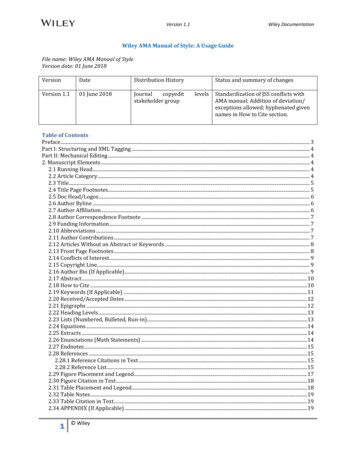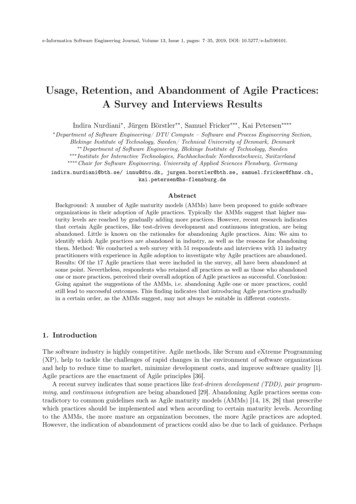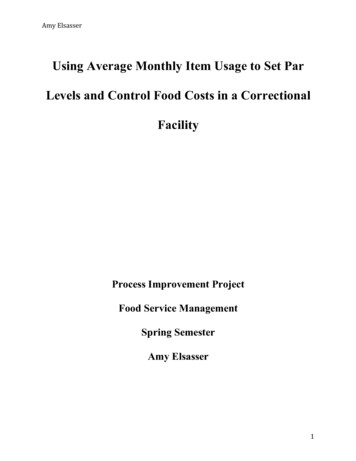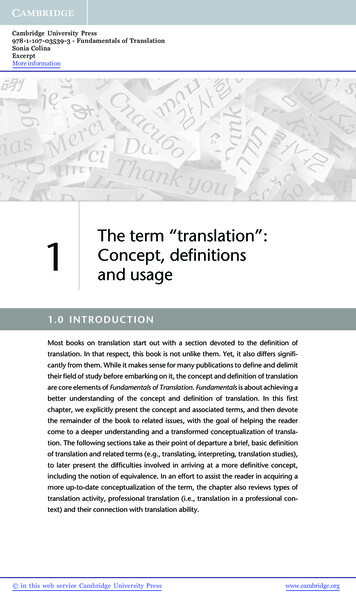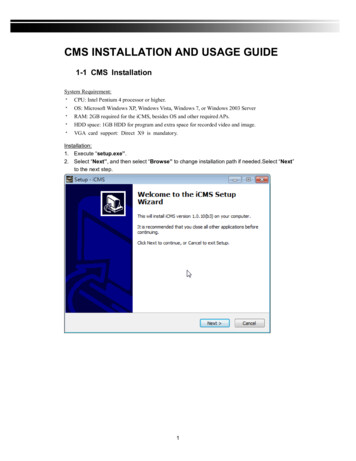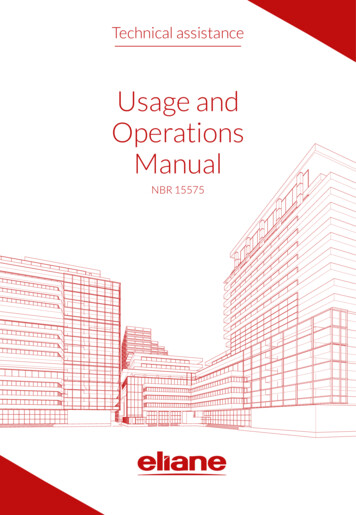
Transcription
Technical assistanceUsage andOperationsManualNBR 15575
Index2. Ceramic Tiles2.1. Wall Tiles2.2. Floor Tiles2.3. Porcelain Tiles3. Planning – choosing the tiles3.1. Care at the work site3.2. Planning the grout and joints4. Quality of Settling Material4.1. Adhesive mortar4.2. Grout mortar5. Quality of Construction and Settlement5.1. Execution of the subfloor5.2. Execution of the plaster on interior walls5.3. Plastering5.4. Execution of the laying5.5. Preparation of adhesive mortar5.6. Application of adhesive mortar5.7. Application of the ceramic tile5.8. Control of adhesion5.9. Open time5.10. Grouting6. Cleaning and Maintenance6.1. Preliminary recommendations6.2. Final maintenance work6.3. Daily Maintenance6.4. Heavy maintenance (specific)6.5. Other Recommendation7. Warranty8. Project 71818191919202123
Hello, welcome to the usage and operation manual for the ceramic tiles usedin your project. This document provides important information about the careand procedures that must be followed so that the service life of the tiles can beassured efficiently.If you received this document from the builder in the delivery of the property,it is because the tiles used on the walls and floors of your property weremanufactured by Eliane Revestimentos Cerâmicos (Eliane Ceramic Tiles).A company that is a leader in the tiles industry with more than 50 years oftradition and experience, it is recognized among one of the biggest and bestcompanies in Brazil in the segment of floor, wall and porcelain tiles.03
2. Ceramic TilesCeramic tiles are used with the purpose of giving value to the environmentwhere they are being laid; making cleaning and maintenance procedurespractical and efficient; restricting and preventing the appearance of moisture;providing thermal comfort; as well as decorating and adding aesthetic value tothe property.Basically, we can classify ceramic tiles in 4 categories: wall tile, floor tile,porcelain tile and mosaics.2.1. Wall TilesProduced to cover the internal walls of buildings, especially in areas wherethere will be frequent or occasional contact with water (kitchen, laundry area,bathrooms, toilets, etc.).Because they are intended for use on walls, they have low mechanical andstrength against abrasion resistance and for this reason cannot be used onfloors.2.2. Floor TilesSuitable to cover all areas of the building or property without restriction ontheir use on floors or walls, however different surfaces are recommended fordifferent places of use as internal and external areas. While, floors for internalareas will privilege the beauty and ease of maintenance, the floor for externaluse should offer resistance and safety to users, therefore, they will havedifferent performances regarding characteristics like ease of cleaning, slip andmechanical resistance.The product choice should always take into account where the product will be04
applied so that no problems occur with the material, thus allowing it to fulfill itspurpose and meet the estimated service life.2.3. Porcelain TilesPorcelain tiles are a ceramic product obtained through the use of high purityraw materials. It is produced at high pressures and temperatures that make it acompact, homogeneous, dense and fully vitrified product.The use of porcelain tiles has as main advantages the extremely high abrasionresistance; being fully waterproof; resistance to ice, acids and alkalis; havinghigh durability when compared to natural stones and other types of ceramic;and more uniform colors.Due to great durability, porcelain tiles are especially suitable for high trafficenvironments, facades and situations where maximum resistance is demanded.However, its beauty and versatility of design also make the Eliane porcelaintiles ideal for residential environments where the aesthetics is key.Porcelain tiles can be produced in the natural, polished, lapado ( semi-polished),through body, and glazed versions.2.4. MosaicsMosaics as well as the other products mentioned above, aims to coat theenvironment making it more beautiful as well as facilitating maintenanceand cleaning procedures. However, different from other products in whichfunctionality is the main attraction, in the case of mosaics their function isfundamentally aesthetic.Mosaics can be produced of ceramics (floor tile or wall tile) or porcelain tiles,05
generally of reduced format (between 2x2 to 4x4 inches) and are available inmesh or in loose individual tiles.In the case of façade applications, in addition to giving value to the building,it reduces the long-term maintenance costs since, when properly laid, theycan last for decades, without the need for exchange or maintenance other thanconventional cleaning.3. Planning – choosing the tilesSpecifying correctly has become very easy. Eliane recommends the place ofuse of all glazed tiles considering their technical characteristics. So you justneed follow the coding below:CodePlace of use - for glazed ceramic tilesLALBResidential bathrooms.Residential environments without street access, such as bathrooms,living rooms, bedrooms and kitchens.Residential environments with and without access to the street,such as bathrooms, rooms, bedrooms, kitchens, garages andbalconies. Commercial areas without street access.Residential and commercial environments with and without accessto the street, such as bathrooms, rooms, bedrooms, kitchens,garages and balconies. Residential and commercial environmentswith and without access to the street, such as bathrooms, rooms,bedrooms, kitchens, garages and balconies.LCLD06
LELPLFSuitable for sidewalks and outdoor areas with flat areas. Residentialand commercial environments with and without access to thestreet, such as bathrooms, rooms, bedrooms, kitchens, garages andbalconies.Swimming PoolsFacades3.1. Care at the work siteWhen receiving the ceramic tiles at the work site, take care that no damage willoccur, thus compromising the quality of the product. It is important that thepackages are stacked in the correct way, thus avoiding damage to the productsuch as breakage in the corners or even the whole piece.Proper Stacking1. Always store thepackages vertically.07
2. Boxers must be carefullystacked up to a maximum heightof 1.5 meters.1,5 m4,5 mPalete3.2. Planning of jointsTiles differ from other types of finishes because they make up mosaicsaccording to the intention of the designer. The grouts are part of the quality ofthe applications and they help in the beauty of the tile.Besides the aesthetic importance, the grouts play an important role becausethey give flexibility to the surface in the accommodation of the pieces.08
The laying of the product and the dimensioning of the structural joints,desolidarization and expansion must be carried out according to therequirements of norm NBR 13753 (Internal or external flooring with ceramictiles using adhesive mortar), under the guidance of the architect or engineerresponsible.The following is an illustrative example:brick structurefloor tileroughcastthinsetmortarleveling coursethinsetgrout linewall tileexpansion jointsgrout linescorner joint linessubstract floorstructural stonessoilNote the different types and width of joints:Structural joints - defined in the project and must be respected during laying.Expansion joints - they are the joints that interrupt the subfloor and areintended to allow for possible dimensional variations. The width should be 10mm and filled with elastic material. These joints shall be provided for at leastevery 6 linear meters for indoors and outdoors areas, within the limits of 20m2 for external floors, 32 m2 for indoors floors and 12 m2 for facades.Desolidarization joints - they are joints with the function of separating thefloor covering to relieve tensions caused by moving the base or the liningitself. They should be placed in the meeting between the floor and the wall and09
around pillars. The width should be 10 mm and may be under a bullnose or befilled with elastic material.Grout - are the joints between the pieces. The minimum width to be observeddepends on the size of the tile and it is always recommended in the productpackaging.4. Quality of Settling MaterialWe recommend observing the following laying rules:NBR 13753NBR 13754NBR 13755Internal or externalfloor covering withceramic tiles and usingadhesive mortar ProcedureCoating of internalwalls with ceramicplates and usingadhesive mortar ProcedureCoating of externalwalls and facades withceramic tiles and usingadhesive mortar Procedure4.1. Adhesive mortarThe quality of the laying material is the second factor related to the durabilityof the tile. The adhesive mortar and grout must also be chosen according tothe environment to be coated. With the objective of ensuring a high qualitylaying system, Eliane Argamassas produces the best mortars and grouts in theBrazilian market. Choose the ideal mortar according to the type and locationof use of the ceramic tile.10
Thinset MortarPlace of useLigamax Gold BasicLaying of ceramic tiles indoors, exceptporcelain.Ligamax Gold ExtraIndoor and outdoor areas. Alsorecommended for laying of floor tiles overexisting floors indoors and for linings inresidential swimming pools.Ligamax Gold AditivadaFor laying of ceramic tiles, in a size of up to20 x 20 cm, on facades and claddings onexternal floors.Ligamax Golda Carga Mineral Adimax Gold SuperLigamax Gold Carga Mineral Adimax Gold PremiumThis dual component system isrecommended for the laying of ceramictiles (any shape) on facades, in thermalpools, Porcelain tile coatings in largeareas (commercial centers, bus terminals,airports, food courts, supermarkets andfactories).This dual component system isrecommended for Porcelain laying onfacades. Also suitable for overlays.Strictly follow the information on the Mortar packaging11
4.2. Grout mortarThe grout mortar contributes significantly to the final visual effect of anenvironment. Eliane Argamassas offers the best solution for the grouting ofceramic tiles. Choose the right product for your work site:GroutWhere to useEpóxi GoldSP 50Ideal for grouting porcelain tiles, natural and syntheticstones, tiles and floors. After application, the product hasa stain resistant surface and a loss of color, with a supersmooth texture. Specially formulated for application inareas where high chemical resistance is not required, suchas residential and commercial areas.JuntaplusGold EpóxiPoolSpecial epoxy grout for swimming pools. It is not harmed bychemicals used in the maintenance of the pool water, doesnot change color, does not crumble, does not absorb waterand does not create mold.JuntaplusGold PiscinaThis mortar is suitable for grouting glazed and unglazedceramic tiles, in places such as bathrooms, facades and,mainly, swimming pools. Its use is recommended inconjunction with Adimax Aditivo (Additive) for Grouting.JuntaplusGold TotalIts use is recommended for grouting glazed and unglazedceramic tiles in internal and external areas. It is advisable toadd Adimax Aditivo for Grouting.Latapoxy2000For grouting in places with high levels of chemicaland mechanical requirements, such as industrialestablishments (dairy and sugar processing plants,breweries, meat processors, beverages and food in general,canning factories, sweets and pharmaceutical industries)and commercial restaurants, cafeterias, laboratories,12
butchers and supermarkets, for example). Latapoxy 2000offers high resistance to acid and bacteria attacks, extremetemperatures, steam washes and heavy traffic, combinedwith easy cleaning and maintenance.Carefully follow the information on the Grout packagingNote: The system composed of the grout products plus grouting mortar cannot be used in order tomake the environment watertight, for this, it should make use of constructive techniques for (sealing forexample).5. Quality of Construction and SettlementThe quality of construction is another important factor. When building aground floor sub-floor for optimal results, follow these guidelines:5.1. Execution of the subfloorThe basic requirements for the execution of the subfloor on the ground floor are:Drainage to eliminate hydrostatic pressure under the building and adjacentareas;Placement of a layer of crushed stone 15 to 20 cm thick between the groundand the subfloor;Layer of concrete of a minimum thickness of 8 cm and with at least 400 kg ofcement per m3, suitably dosed with a low water to cement ratio. It needs to bevibrated and cured;13
The surface must be flat, rough, free of cracks and free from factors that reduceadhesion such as excessive moisture, oils, greases and other;Waterproofing of the subfloor if necessary;Application of a noise reducing shield if necessary.expansion jointssmoothing layerfloor tilethinsetexpansion jointsgrout linesubstract floorstructural stonessoil5.2. Execution of the plaster on interior walls If the masonry is made of ceramic bricks, they should be of good quality; Concrete blocks should have low water absorption and be properly cured,plumbed and with resistant mortar; The wall must be clean, have a regular surface, be flat, free from cracksand free from factors that reduce adhesion such as: excessive moisture, oils,greases and other; Before applying the plaster it is common to scrub the surface of the blocks14
with suitable mortar. This slab increases the contact area of the plaster andensures adhesion; Prepare spray on mortar with one part of cement for two of coarse washedsand; For any type of base, moisten it with the aid of a brush; For wet areas, we recommend applying waterproofing of up to 1,5m high onthe walls with the objective of avoiding infiltration and problems arising fromhumidity.5.3. PlasteringWithin 24 hours after rough plastering, start the fine plastering. Use 1 part ofcement for 5 of medium river sand and 0.5 or ½ of good quality lime, which canbe replaced by plasticizer. If you prefer to use prefabri
manufactured by Eliane Revestimentos Cerâmicos (Eliane Ceramic Tiles). A company that is a leader in the tiles industry with more than 50 years of tradition and
